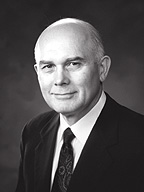Dallin H. Oaks, “The Witness: Martin Harris,” Ensign, May 1999, 35, Excerpt

Dallin H. Oaks
Book of Mormon Witnesses
There are witnesses of the Book of Mormon itself. I have chosen to speak about the significance of their testimonies and about the life of one of them.
While Joseph Smith was translating the Book of Mormon, the Lord revealed that, in addition to the Prophet’s testimony, the world would have “the testimony of three of my servants, whom I shall call and ordain, unto whom I will show these things” (D&C 5:11; see also Ether 5:2–4; 2 Ne. 27:12–13). “They shall know of a surety that these things are true,” the Lord declared, “for from heaven will I declare it unto them” (D&C 5:12).
There were also eight witnesses, but their testimony is a subject for another time.
The three men chosen as witnesses of the Book of Mormon were Oliver Cowdery, David Whitmer, and Martin Harris. Their written “Testimony of Three Witnesses” has been included in all of the almost 100 million copies of the Book of Mormon the Church has published since 1830. These witnesses solemnly testify that they “have seen the plates which contain this record” and “the engravings which are upon the plates.” They witness that these writings “have been translated by the gift and power of God, for his voice hath declared it unto us.” They testify, “We declare with words of soberness, that an angel of God came down from heaven, and he brought and laid before our eyes, that we beheld and saw the plates, and the engravings thereon; and we know that it is by the grace of God the Father, and our Lord Jesus Christ, that we beheld and bear record that these things are true.”
Further, “the voice of the Lord commanded us that we should bear record of it; wherefore, to be obedient unto the commandments of God, we bear testimony of these things” (“The Testimony of Three Witnesses,” Book of Mormon).
People who deny the possibility of supernatural beings may reject this remarkable testimony, but people who are open to believe in miraculous experiences should find it compelling. The solemn written testimony of three witnesses to what they saw and heard—two of them simultaneously and the third almost immediately thereafter—is entitled to great weight. Indeed, we know that upon the testimony of one witness great miracles have been claimed and accepted by many religious people, and in the secular world the testimony of one witness has been deemed sufficient for weighty penalties and judgments.
Persons experienced in evaluating testimony commonly consider a witness’s opportunity to observe an event and the possibility of his bias on the subject. Where different witnesses give identical testimony about the same event, skeptics look for evidence of collusion among them or for other witnesses who could contradict them.
Measured against all of these possible objections, the testimony of the Three Witnesses to the Book of Mormon stands forth in great strength. Each of the three had ample reason and opportunity to renounce his testimony if it had been false, or to equivocate on details if any had been inaccurate. As is well known, because of disagreements or jealousies involving other leaders of the Church, each one of these three witnesses was excommunicated from The Church of Jesus Christ of Latter-day Saints by about eight years after the publication of their testimony. All three went their separate ways, with no common interest to support a collusive effort. Yet to the end of their lives—periods ranging from 12 to 50 years after their excommunications—not one of these witnesses deviated from his published testimony or said anything that cast any shadow on its truthfulness.
Furthermore, their testimony stands uncontradicted by any other witnesses. Reject it one may, but how does one explain three men of good character uniting and persisting in this published testimony to the end of their lives in the face of great ridicule and other personal disadvantage? Like the Book of Mormon itself, there is no better explanation than is given in the testimony itself, the solemn statement of good and honest men who told what they saw.
